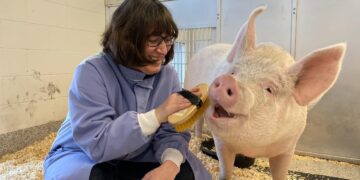Table of Contents
Introduction: The Heart of the Matter
The decision to bring a dog into one’s life is a profound one, a turning point marked by the anticipation of companionship, loyalty, and unconditional love.
For the conscientious Bay Area adopter, this is not a transaction to be rushed but a journey to be undertaken with care, research, and heart.
It is a commitment to providing a forever home, a promise of a second chance.
Yet, this personal journey unfolds against a complex and often challenging local backdrop.
The Bay Area, a region celebrated for its deep love of animals, is simultaneously grappling with a critical overpopulation crisis in its animal shelters.1
This is not a crisis fueled by whim.
The pervasive narrative of the “unwanted pandemic pet” being flagrantly surrendered as lockdowns ease does not capture the full, heartbreaking picture.2
Instead, the primary drivers are economic hardship and a lack of affordable, dog-friendly housing, which force devoted owners to make agonizing decisions.2
This reality elevates the act of adoption from a simple choice to a vital intervention.
It is an act that saves a life and, in doing so, creates space for another animal in need.
The sheer number of organizations dedicated to this cause in the Bay Area is a testament to the community’s compassion, but it can also be overwhelming.
From large, historic institutions to nimble, volunteer-run foster networks and highly specialized rescues, the options are vast and varied.
Each operates with a unique process, philosophy, and set of resources.
This guide is designed to be a comprehensive map through that intricate landscape.
It will not declare a single “best” shelter, because “best” is a deeply personal equation.
Instead, this report will empower the reader—the thoughtful, dedicated adopter—to find the organization and, ultimately, the dog that is truly the best fit for their life.
By deconstructing the adoption ecosystem, demystifying the matchmaking process, and providing a clear blueprint for navigating the crucial first months, this guide will illuminate the path to a successful, joyful, and lifelong bond.
Part I: Navigating the Landscape: A Systems Approach to the Bay Area’s Rescue Ecosystem
To truly understand dog adoption in the Bay Area, it is helpful to move beyond a simple list of shelters and instead view the landscape as a complex, interconnected system.
Each organization, with its distinct operational model, fills a specific niche and contributes to the overall health of the animal welfare community.
A large, facility-based shelter might excel at high-volume intake and providing immediate, accessible veterinary care, while a foster-based rescue offers an unparalleled in-home assessment of a dog’s true personality.
These are not competing models but complementary ones, each with strengths and trade-offs.
The “best” choice for an adopter is not about finding a universally superior organization, but about understanding which part of this dynamic system best aligns with their individual needs, lifestyle, and philosophy.
This systems thinking approach transforms an overwhelming array of choices into a clear, strategic decision-making process, allowing adopters to find their perfect place within this compassionate ecosystem.3
The Pillars of the Community: Large-Scale, Facility-Based Shelters
These organizations are the cornerstones of animal welfare in the Bay Area, often with deep historical roots and extensive infrastructure.
They serve as high-capacity hubs, taking in thousands of animals each year and acting as a critical safety net for the community’s most vulnerable pets.
Key Organizations:
- San Francisco SPCA (SF SPCA): A landmark institution in San Francisco’s Mission District, founded in 1868.5
- Joybound People & Pets (formerly ARF): Located in Walnut Creek, this organization emphasizes the human-animal bond through a variety of programs beyond adoption.7
- Marin Humane: A major center in Novato that expanded its reach by merging with the foster-based Hopalong Animal Rescue.8
- Berkeley Humane: A key resource serving the East Bay community.9
Key Characteristics:
- Accessibility and Efficiency: A defining feature of many large shelters is their streamlined adoption process. The SF SPCA, for example, operates on a walk-in, first-come, first-served basis, with no advance appointment required. This model facilitates same-day adoptions, allowing a prepared adopter to meet and take home their new companion in a single visit that typically takes about an hour.5 This efficiency is crucial for managing the high volume of animals they care for and for making adoption as accessible as possible.
- Comprehensive On-Site Resources: The scale of these organizations allows them to house remarkable resources under one roof. They typically have full-service veterinary clinics capable of providing all necessary medical care, from spay/neuter surgery to more complex treatments.6 Perhaps their most significant advantage is access to specialized behavioral support. The SF SPCA’s Veterinary Behavior Service is a prime example, led by Dr. Alison Gerken, the only board-certified veterinary behaviorist in San Francisco.10 This level of expert help for issues like severe anxiety or aggression is a rare and invaluable resource for adopters facing challenges.10
- Value-Inclusive Adoption Fees: The adoption fee at these shelters is an investment that covers a comprehensive package of essential services. A typical adoption includes the spay or neuter surgery, all age-appropriate vaccinations, a microchip with registration, deworming, and preventative flea and tick medication.5 Many, like the SF SPCA, also send adopters home with a starter kit containing a few days’ worth of food, a collar, and a leash, ensuring the new family is equipped from day one.5
- The Shelter Environment Trade-off: Despite modern designs like the SF SPCA’s pioneering cage-free “condos” 11, a shelter environment is inherently stressful for many dogs. The constant noise and proximity to other animals can lead to behaviors like “barrier-related barking” or “kennel displaying,” where a dog lunges and barks at the front of its enclosure out of frustration or fear.12 This behavior can be misinterpreted by potential adopters as aggression, masking the dog’s true, calmer personality that would emerge in a home setting.12
The Home-Based Heroes: Foster-Network Rescues
In contrast to large facilities, foster-based rescues operate as a distributed network of volunteer homes.
These organizations are the agile and deeply personal heart of the rescue system, providing a crucial bridge for dogs who would not thrive in a traditional shelter.
Key Organizations:
- Rocket Dog Rescue: A prominent, volunteer-run organization saving dogs from overcrowded shelters across the Bay Area.13
- Copper’s Dream Rescue: An all-breed, foster-based rescue that saves dogs from shelters and finds them homes through a network of fosters and adoption events.15
- Underdog Animal Rescue: A Lafayette-based group that focuses on “underdogs”—those with significant medical or behavioral needs who are often overlooked.17
- Furry Friends Rescue: An all-volunteer group rescuing dogs and cats since 1998, placing them in a network of foster homes.18
- Doggie Protective Services (DPS): Another well-regarded, all-foster rescue mentioned by community members.15
Key Characteristics:
- Accurate In-Home Assessment: The single greatest advantage of the foster model is the ability to see how a dog behaves in a real home environment. Information about a dog’s house-training status, crate manners, energy levels, and interactions with family members is not a guess but a direct observation.19 This provides a much more reliable picture of the dog’s temperament than can be gleaned from a short interaction in a stressful shelter.15
- Rich, Personalized Information: Foster parents become the dog’s primary advocate and source of information. They can provide nuanced details about a dog’s personality, quirks, favorite games, and specific needs, which is invaluable for creating a successful and lasting match.19 This direct pipeline of information from someone who lives with the dog 24/7 is a unique benefit of this model.
- A Curated, Application-First Process: The journey with a foster-based rescue typically begins online. Prospective adopters fill out a detailed application, which is then reviewed by the organization. If it seems like a potential match, the application is forwarded to the foster parent, who then contacts the adopter to share more information and schedule a meet-and-greet.14 This process is more deliberate and less spontaneous than a walk-in shelter visit, functioning as a more personalized matchmaking service.
- Deep Community Integration: Lacking a central facility, these rescues are deeply embedded in the community. They are highly visible at local adoption events, often hosted by partners like Pet Food Express, where potential adopters can meet multiple dogs at once.8 This grassroots presence fosters a strong sense of community among volunteers and adopters alike.
The Specialists: Niche and Breed-Focused Rescues
A vital part of the Bay Area’s rescue ecosystem is comprised of groups that dedicate their resources to a specific, often underserved, population of dogs.
Their focused expertise and tailored programs provide exceptional care and advocacy.
The Senior Savior: Muttville Senior Dog Rescue
- Mission and Philosophy: Muttville has earned national acclaim for its revolutionary approach to senior dog rescue. Its mission is to change the way the world thinks about and treats older dogs, creating better lives for them through rescue, foster, adoption, and hospice care.21 They give a second chance to dogs aged seven and older who are often at the highest risk in traditional shelters.
- A Unique Environment: Muttville is famous for its cage-free “doggy loft,” a vibrant and comfortable headquarters designed to be a paradise for senior dogs and the people who love them.21 This approach minimizes stress and allows the dogs’ true, sweet personalities to shine.
- The “Seniors for Seniors” Program: This flagship program is a beautiful example of symbiotic matchmaking. For adopters aged 62 and over, Muttville waives its standard $250 adoption fee. More than just a fee waiver, the program provides a comprehensive welcome kit to ensure both senior human and senior dog have everything they need to start their new life together, including a harness, leash, bowls, food, medication, a bed, and even home modifications like a doggy gate if needed.22
Breed-Specific Groups
While the Bay Area has fewer standalone, breed-specific rescue headquarters compared to all-breed organizations, those looking for a particular type of dog are not without options.
Large municipal shelters like Contra Costa County Animal Services regularly have purebreds and recognizable mixes such as Pit Bull Terriers, Siberian Huskies, German Shepherds, and Chihuahuas available for adoption.5
For those with their heart set on a specific breed, the best strategy is twofold: continuously monitor the websites of the large Bay Area shelters and search for national or regional breed-specific rescue clubs (e.g., “NorCal Golden Retriever Rescue”) that operate through foster networks within the Bay Area.
Part II: The Matchmaking Process: A Professional Approach to Finding Your Dog
The most successful and reputable animal rescue organizations in the Bay Area operate with a philosophy that mirrors the world of professional matchmaking.
This is not about creating barriers or being exclusionary; it is a sophisticated, compatibility-focused approach designed to create lasting, successful relationships between dogs and humans.
By understanding the adoption process through this lens, potential adopters can better appreciate the purpose behind each step and engage more effectively as an active partner in finding their perfect match.
The process, whether at a large shelter or a foster network, can be broken down into the same core stages as a high-end matchmaking service: a detailed intake, a compatibility assessment and consultation, a curated introduction, and post-date feedback.25
The Intake & Profile: Honesty in Your Application
The journey almost always begins with an application.
This document, which can sometimes feel long and intrusive, is the foundational “confidential profile” of the matchmaking process.27
Its purpose is not to be an exam that one can pass or fail, but to provide the rescue organization with a clear and honest picture of the applicant’s life, home, and expectations.
Organizations like Furry Friends Rescue use their detailed online application to gather crucial information about an adopter’s living situation (renting vs. owning, apartment vs. house), family structure, work schedule, and experience level with dogs.18
It is absolutely critical for applicants to be authentic in their responses.
Exaggerating one’s activity level or being less than truthful about work-from-home plans is a direct path to a mismatch and, potentially, a failed adoption.
A high-energy dog placed in a low-activity home where the owner is gone for ten hours a day is a scenario destined for frustration for both human and canine.28
Reputable rescues are not looking for a “perfect” applicant, but an honest one, so they can make a genuinely compatible match.
Common reasons for an application to be declined at this stage often involve logistical hurdles, such as not having written approval from a landlord to have a pet of a certain size or breed, or a clear mismatch between the adopter’s lifestyle and the specific needs of the dog they are interested in.5
The Consultation: Adoption Counseling & Temperament Assessment
Once an application is reviewed, the next step is the consultation.
This is where the human element of matchmaking truly comes into play.
The adoption counselor, whether a paid staff member at a large shelter or a dedicated volunteer at a rescue, acts as the “professional matchmaker”.8
They are not simply gatekeepers; they are guides who have invested time in getting to know the animals’ individual personalities and needs, and their goal is to facilitate a successful placement.5
Some organizations have formalized this matchmaking philosophy into a structured program.
Joybound People & Pets, for instance, utilizes the ASPCA’s “Meet Your Match” program.29
This research-based system uses a “Canine-ality” assessment to understand a dog’s behavior and interests, and an adopter survey to understand the person’s preferences and lifestyle.
The results, often color-coded, help guide the conversation and match, for example, a high-energy “Go-Getter” dog with an active family, or a calm “Couch Potato” with a more sedentary household.
This approach has been shown to significantly increase adoption rates and, just as importantly, decrease the number of dogs returned to the shelter.30
Part of this consultation phase often involves discussing a dog’s temperament assessment.
It is important for adopters to understand what these tests are—and what they are not.
Shelters use them to evaluate a dog’s reaction to strangers, handling, and potential triggers like food bowls or other dogs, primarily to screen for overt aggression.31
Marin Humane, for example, bases its evaluations on the “Assess-a-Pet” test, which was specifically designed to reveal what a dog would be like with an average adopter, not just a professional trainer.33
However, these tests are not without controversy.
A dog that is terrified and stressed in a shelter environment may react poorly to a test, leading to a negative label that doesn’t reflect its true nature.31
A skilled adoption counselor can provide crucial context for these assessments, helping an adopter understand the full picture.
The First Date: Mastering the Meet-and-Greet
The meet-and-greet is the “first date” of the adoption world—the exciting and pivotal moment of in-person connection.
Whether it takes place in a play yard at a shelter, a living room at a foster home, or a neutral park, approaching it with thoughtfulness can make all the difference.34
A Protocol for Success:
- Involve the Whole Team: Whenever possible, all members of the household should attend the meeting. A dog’s reaction to children, for example, is a critical piece of information, and it’s essential that everyone in the family is on board with the decision.5
- Facilitate a Canine Introduction: If there is a resident dog, many organizations like the SF SPCA require or strongly encourage a dog-to-dog introduction on-site to gauge compatibility from the start.5
- Ask Insightful Questions: This is the opportunity to learn things a written bio can’t convey. Especially when meeting with a foster parent, adopters should come prepared with questions.35 Good questions include: “Can you tell me the story of how they came into rescue?”, “What is their typical energy level on a rainy day versus a sunny day?”, “How do they react to being left alone?”, and “Have you noticed any fears, anxieties, or specific behavioral quirks like guarding toys or food?”.12
- Observe and Interact: Pay close attention to the dog’s body language. A dog that is relaxed and seeks gentle physical contact is showing positive signs. It is also a good idea to see how the dog responds to your voice and to simple interactions like playing with a toy.36
- Embrace the “Sleep On It” Rule: The experience of meeting a potential new dog is emotionally charged. It is easy to get swept up in the excitement. Reputable organizations understand this and will not pressure an immediate decision. Taking a night to process the interaction and discuss it with family members is a wise step that ensures the decision is made with a clear head.35 A great match will still be a great match the next day.
Part III: The Bay Area’s Top Adoption Destinations: In-Depth Profiles & Comparative Analysis
Choosing where to begin the adoption journey is the first major decision an adopter will make.
The Bay Area offers a rich tapestry of options, each with its own culture, process, and area of focus.
To simplify this choice, the following table provides an at-a-glance comparison of some of the region’s most prominent and well-regarded organizations.
This resource distills a vast amount of information into a clear, comparative format, allowing a potential adopter to quickly identify the organizations that best align with their logistical needs and personal preferences, saving hours of research and reducing the initial feeling of being overwhelmed.
Following the table, narrative profiles offer a deeper dive into the unique character of each organization.
Table 1: Bay Area Dog Adoption Centers at a Glance
| Organization Name | Location(s) | Adoption Model | Key Feature | Adoption Fee (Puppy/Adult) | Process Overview |
| SF SPCA | San Francisco | Shelter | On-site vet behaviorists; Walk-in, same-day adoptions 5 | $400 / $175 5 | Walk-in, first-come, first-served. No appointment needed.5 |
| Joybound People & Pets | Walnut Creek | Shelter | “Meet Your Match” program; extensive post-adoption resources 7 | $375 / $150 7 | Sign-in, complete matchmaker profile, consult with counselor.7 |
| Marin Humane | Novato | Shelter (w/ Foster Network) | Hopalong Rescue partnership; mobile adoption events 8 | $400 / $175 8 | Submit “Pets & People Profile” first, then schedule an appointment.8 |
| Muttville | San Francisco | Shelter (Cage-Free) | Senior dog (7+) specialist; “Seniors for Seniors” program 21 | $0 – $250 (Fee waived for adopters 62+) 23 | Fill out questionnaire first, then arrange a meet-and-greet.23 |
| Rocket Dog Rescue | Oakland/SF | Foster Network | Focus on at-risk dogs from overcrowded shelters; strong volunteer community 13 | Varies | Submit application first, then a volunteer coordinates a meeting.14 |
| Copper’s Dream | SF Bay Area | Foster Network | All-breed, all-foster rescue with regular adoption events 15 | Varies | Submit application to get started; meet dogs at events or via foster.16 |
| Furry Friends Rescue | SF Bay Area | Foster Network | Detailed 5-step adoption process; rescues both dogs and cats 18 | Varies | App -> Virtual Meet -> In-Person Meet -> Home Visit -> Adoption.18 |
| Underdog Animal Rescue | Lafayette | Foster Network | Focus on medically or behaviorally needy “underdogs” 17 | Varies | Submit application first to begin the process.17 |
Narrative Profiles
SF SPCA
As one of the oldest and most influential humane societies in the country, the SF SPCA is a powerhouse of animal welfare in the Bay Area.
Its state-of-the-art facility in the Mission is a hub of activity, offering not only adoptions but also world-class veterinary care.6 Their adoption process is designed for accessibility, operating on a walk-in basis that allows for same-day adoptions.5 This makes it an excellent choice for adopters who are prepared and ready to act.
The true jewel in their crown is the on-site Veterinary Behavior Service, which provides a level of expert support for challenging behaviors that is unparalleled in the region.10 Adopting from the SF SPCA means tapping into a comprehensive system of care that extends well beyond the adoption day itself, with post-adoption counseling readily available.11
Joybound People & Pets
Formerly known as Tony La Russa’s Animal Rescue Foundation (ARF), Joybound People & Pets in Walnut Creek has a deep-seated philosophy centered on the transformative power of the human-animal bond.7 Their adoption process is a clear example of the matchmaking approach, utilizing the ASPCA’s “Meet Your Match” program to ensure compatibility.29 This involves a thoughtful consultation with an adoption counselor who uses a profile form to understand the adopter’s lifestyle and introduce them to suitable dogs.7 Joybound also offers a rich array of post-adoption programs, including grooming services and training classes, reinforcing their commitment to supporting the entire life of the pet and its family.7
Marin Humane
Located in Novato, Marin Humane serves the North Bay with a wide range of services, from animal law enforcement training to public clinics.8 Their adoption program was significantly enhanced in 2021 through a merger with Hopalong Animal Rescue, which integrated a robust foster network into their existing shelter model.
This hybrid approach gives adopters the best of both worlds: the resources of a large facility and the in-home insights of a foster network.8 Their process is more deliberate than a walk-in model, requiring potential adopters to first fill out a “Pets & People Profile” to help their “professional matchmakers” find the right animal before scheduling a meeting.8 They are also highly active in the community, with frequent mobile adoption events at local businesses.8
Muttville Senior Dog Rescue
Muttville is more than a rescue; it’s a movement.
From its colorful, cage-free headquarters in San Francisco, this organization has changed the narrative for senior dogs.21 By focusing exclusively on dogs aged seven and older, they provide a loving sanctuary and a second chance for animals often overlooked.
Their process begins with an online questionnaire tailored to the unique needs of senior dogs, including a separate one for their hospice program.23 The “Seniors for Seniors” program is a standout, beautifully connecting senior citizens with senior dogs in a mutually beneficial relationship, complete with waived fees and a full starter kit.22 Adopting from Muttville is an act of profound compassion, supported by a deeply passionate and knowledgeable community.
Foster-Based Rescues (Rocket Dog, Copper’s Dream, and more)
Organizations like Rocket Dog Rescue, Copper’s Dream, Furry Friends Rescue, and Underdog Animal Rescue form the vital, decentralized network of Bay Area rescue.
Without physical shelters, they rely on the dedication of volunteer foster parents who open their homes.17 This model’s strength is the quality of information it provides.
An adopter isn’t just meeting a dog; they are talking to the person who has lived with that dog, who knows their sleeping habits, their potty-training progress, and their little personality quirks.19 The process is inherently more personal and curated.
It starts with an online application, followed by a conversation or email exchange with the foster, and culminates in a meet-and-greet.14 For adopters who value detailed, firsthand knowledge and are willing to engage in a more multi-step process, these rescues offer an unparalleled path to finding a well-understood companion.
Part IV: The First 90 Days: A Blueprint for a Successful Transition
A successful adoption is not a single event that concludes when the paperwork is signed; it is the beginning of a process.
The first few weeks and months are a critical transition period for both the dog and the new family.
This is when the foundation for a lifelong bond is built, and it is also when challenges are most likely to arise.
Research shows that behavioral issues are the single most common reason for dogs being returned to shelters, accounting for over 36% of returns.38
Many of these issues, however, are not permanent flaws in the dog’s character but predictable, understandable, and often temporary responses to the immense stress of rehoming.
The shelter environment itself can induce problems like housetraining regression, barrier frustration that manifests as leash reactivity, and social hyper-arousal.12
By understanding the “why” behind these behaviors and having a clear plan, new adopters can transform from frustrated owners into patient and effective teachers, dramatically increasing the odds of a happy outcome.
Welcome Home: The Decompression Protocol
A newly adopted dog has just had its entire world turned upside down.
They have lost their previous environment and are now in a new place with new people, new sounds, and new smells.
The most compassionate and effective thing a new owner can do is give them time to adjust.
Many rescue professionals advocate for a “two-week shutdown” or a decompression period.39
This doesn’t mean ignoring the dog, but rather managing their environment to minimize stress and prevent overwhelming them.
Key steps for a smooth decompression include:
- Create a Safe Haven: Designate a quiet, safe space for the dog, such as a crate in a low-traffic area or a separate room with a comfortable bed. This gives them a place to retreat to when they feel overwhelmed.
- Establish a Predictable Routine: Dogs thrive on routine. Establishing a consistent schedule for feeding, potty breaks, and walks from day one helps the dog learn what to expect and feel more secure.40
- Limit Introductions: Avoid the temptation to invite all your friends and family over to meet the new dog in the first week. Similarly, avoid trips to busy places like dog parks or cafes. Keep the circle small and the environment calm to allow the dog to bond with its immediate family first.
- Use Management Tools: Use baby gates, crates, and leashes (even indoors) to manage the dog’s freedom. This prevents them from getting into trouble or having accidents, setting them up for success rather than correcting failure.41
Understanding Your Rescue’s Past: Common Behavioral Hurdles
Many behaviors that new owners find challenging are direct results of the dog’s past experiences.
Recognizing the root cause is the first step toward addressing the behavior with empathy and effective training.
Table 2: Common Rescue Dog Behaviors & First-Step Solutions
| Behavior Challenge | Potential Causes (Shelter Stress, Past Trauma) | Initial Management & Training Strategy | When to Seek Professional Help |
| Separation Anxiety | Fear of being abandoned again; over-attachment after rehoming; lack of coping skills.12 | Create positive associations with departure (e.g., special puzzle toy only given when leaving). Keep arrivals and departures low-key. Practice very short, gradual absences.42 | If the dog is destructive, self-harming (e.g., excessive licking, chewing paws), or cannot be left alone for even short periods without panicking. |
| Destructive Chewing | Boredom; pent-up energy; anxiety; exploring a new environment with their mouth (especially puppies).28 | “Puppy-proof” the house by removing tempting items. Provide a variety of appropriate chew toys and puzzle feeders. Ensure adequate daily physical exercise and mental stimulation.28 | If the chewing is a symptom of severe separation anxiety or is causing significant property damage or risk of ingestion. |
| Housetraining Regression | Forced to eliminate in their kennel, breaking the habit of holding it; poor generalization (dog doesn’t understand the “no potty inside” rule applies to this new house).12 | Treat the dog like an untrained puppy. Take them out for frequent potty breaks (especially after waking, eating, and playing), and reward lavishly for success outside. Supervise closely indoors and use a crate or gates when supervision isn’t possible.12 | If there is no improvement after several weeks of consistent management and positive reinforcement, or to rule out a medical issue like a UTI.28 |
| Leash Reactivity (Barking/Lunging) | Barrier frustration learned in the kennel (repeatedly seeing people/dogs they can’t greet); fear or anxiety about other dogs or people.12 | Increase the distance between your dog and their triggers to a point where they can notice but not react. Use high-value treats to create a new, positive association with seeing the trigger (counter-conditioning). Avoid punishment, which can increase fear.41 | If the behavior is severe, poses a safety risk to you or others, or is not improving with management. |
| Resource Guarding (Food, Toys) | Past life of scarcity where they had to protect resources to survive; a way to control their environment when everything else feels out of control.40 | Do not confront the dog or snatch items away. Instead, practice “trading up”—offering something of higher value (like a piece of chicken) in exchange for the item they have. Hand-feed meals to build trust.44 | Immediately. This behavior can escalate and lead to bites. It requires the guidance of a qualified, force-free professional. |
Building a New Bond: The Power of Positive Training
The prevailing training philosophy among the Bay Area’s leading animal welfare organizations is clear and consistent: modern, science-based, positive reinforcement.
The SF SPCA and East Bay SPCA, among others, explicitly advocate for reward-based methods and advise against the use of punitive tools like choke chains, prong collars, or shock collars.41
This philosophy is built on a simple but powerful principle: reward the behavior you want to see.
A reward can be anything the dog finds motivating—a tasty treat, a favorite toy, enthusiastic praise, or a good belly rub.41
By consistently rewarding a dog for making a good choice (like sitting instead of jumping), you make that choice more likely to happen in the future.
This approach does more than just teach commands; it builds a relationship based on trust and positive communication.
It reframes the owner’s role from that of a disciplinarian who punishes mistakes to that of a good teacher who helps their student succeed.41
Punishment, conversely, can create fear and anxiety, which inhibits learning and can damage the human-animal bond.41
When to Call for Backup: A Directory of Bay Area Behavior Experts
While many common challenges can be managed with patience and good training, some issues require professional intervention.
Adopters should seek help from a qualified professional for any signs of aggression, severe anxiety, or any behavior that poses a safety risk to the dog, the family, or the community.
The Bay Area is fortunate to have a wealth of expert resources.
- Veterinary Behaviorists: For the most complex cases, especially those that may have a medical component or require anti-anxiety medication, a board-certified veterinary behaviorist is the highest level of expert. The SF SPCA’s Veterinary Behavior Service, led by Dr. Alison Gerken, DACVB, is the premier resource in San Francisco.10 They offer comprehensive consultations and can work directly with a family’s primary veterinarian, which can be a cost-effective first step.10
- Certified Professional Dog Trainers & Behavior Consultants: For hands-on help with issues like leash reactivity, fear, and resource guarding, a certified trainer or consultant is essential. Look for credentials from reputable organizations like the Certification Council for Professional Dog Trainers (CCPDT) or the International Association of Animal Behavior Consultants (IAABC).46 Bay Area resources include
The Pooch Coach, who specializes in aggression and fear 44;
Bay Area Dog Training, offering private lessons since 1980 47; and
True Training, which focuses on helping reactive dogs relax using force-free methods.48 - Group Training Classes: For building basic manners, socialization, and a positive training foundation, group classes are an excellent option. Many of the large shelters offer their own suite of classes, such as the “Puppy Stars” program at the East Bay SPCA 45 or the various dog training classes offered by the
SF SPCA 41 and
Joybound.7
Conclusion: The Journey Begins
The path to adopting a dog in the Bay Area is one filled with immense hope and possibility.
It is a journey that can transform the life of a deserving animal while deeply enriching one’s own.
The stories of success are a powerful testament to this.
They are stories like that of Tempura, a dog returned to a shelter after two years, suffering from neglect, who was rescued and treated, and now spends his days strolling through the beautiful parks of San Francisco with his new family.49
They are stories of serendipity, like that of Jazz and Zoe, two husky mixes adopted nearly three years apart by the same Santa Clara family, who later discovered through a DNA test that their beloved pets were, in fact, long-lost sisters.50
And they are stories of the profound joy felt by foster parents who provide a temporary haven and then watch their dog blossom in a forever home, knowing they were a crucial bridge to that new life.51
Adopting a dog is a significant commitment—one that requires patience, education, and empathy.
The challenges, particularly in the beginning, are real.
A rescue dog’s past is often unknown, and the transition into a new home takes time.
But as this guide has shown, the resources available to adopters in the Bay Area are abundant and world-class.
From the professional matchmaking of adoption counselors to the expert guidance of veterinary behaviorists and the supportive community of fellow adopters, no one has to navigate this journey alone.
By making a thoughtful, conscientious choice, by embracing the role of a patient teacher, and by meeting challenges with understanding, a new adopter does more than just save a dog.
They begin a remarkable journey of mutual rescue, forging a bond of love and loyalty that will last a lifetime.
Works cited
- Too many animals: Shelters, rescue groups face critical lack of room for unadopted pets, accessed August 12, 2025, https://localnewsmatters.org/2024/03/22/too-many-animals-shelters-rescue-groups-face-critical-lack-of-room-for-unadopted-pets/
- The real reasons Bay Area shelters are flooded with large dogs – SFGATE, accessed August 12, 2025, https://www.sfgate.com/local/article/Why-Bay-Area-shelters-are-full-of-large-dogs-17151362.php
- Principles of Systems Thinking – SEBoK, accessed August 12, 2025, https://sebokwiki.org/wiki/Principles_of_Systems_Thinking
- What is Systems Thinking? Everything You Need to Know (2025) – SixSigma.us, accessed August 12, 2025, https://www.6sigma.us/systems-thinking/what-is-systems-thinking/
- Adoptions – San Francisco SPCA, accessed August 12, 2025, https://www.sfspca.org/adoptions/
- Home Page – San Francisco SPCA, accessed August 12, 2025, https://www.sfspca.org/
- Joybound People & Pets (formerly ARF), accessed August 12, 2025, https://joybound.org/
- Marin Humane – Animals for Adoption and Marin Animal Services, accessed August 12, 2025, https://marinhumane.org/
- Bay Area Animal Shelters – Berkeley Humane, accessed August 12, 2025, https://berkeleyhumane.org/community-resources/local-shelters/
- Veterinary Behavior Service – San Francisco SPCA, accessed August 12, 2025, https://www.sfspca.org/veterinary-care/veterinary-behavior-service/
- Public Disclosure Copy | SF SPCA, accessed August 12, 2025, https://www.sfspca.org/wp-content/uploads/2023/07/SFSPCA-2019-Form-990-Public-Disclosure-Copy.pdf
- Behavior Problems and Long Term Housing – Maddie’s Fund, accessed August 12, 2025, https://www.maddiesfund.org/behavior-problems-and-long-term-housing.htm
- Rocket Dog Rescue: Home, accessed August 12, 2025, https://www.rocketdogrescue.org/
- Our Dogs – Rocket Dog Rescue, accessed August 12, 2025, https://www.rocketdogrescue.org/adopt/adoptees/
- What are some top dog adoption centers around the South Bay area? : r/bayarea – Reddit, accessed August 12, 2025, https://www.reddit.com/r/bayarea/comments/1m0pd2d/what_are_some_top_dog_adoption_centers_around_the/
- Copper’s Dream Rescue: Home, accessed August 12, 2025, https://www.coppersdream.org/
- Underdog Animal Rescue | dog rescue | Lafayette, CA, USA, accessed August 12, 2025, https://www.underdogca.com/
- Home | Furry Friends Rescue – Dog & Cats Adoption, Fostering in …, accessed August 12, 2025, https://www.furryfriendsrescue.org/
- MUTTVILLE SENIOR DOG RESCUE, accessed August 12, 2025, https://muttville.org/pdfs/MuttvilleFosterManual-January2019.pdf
- Reputable rescue? : r/AskSF – Reddit, accessed August 12, 2025, https://www.reddit.com/r/AskSF/comments/1ayiuzn/reputable_rescue/
- Muttville, accessed August 12, 2025, https://muttville.org/
- Seniors for Seniors | Muttville, accessed August 12, 2025, https://muttville.org/seniors_for_seniors
- How to adopt | Muttville, accessed August 12, 2025, https://muttville.org/how_to_adopt
- Available Dogs | Contra Costa County, CA Official Website, accessed August 12, 2025, https://www.contracosta.ca.gov/7885/Available-Dogs
- The Power of Match making: How Professional Services Can Transform Your Search for Love, accessed August 12, 2025, https://soulmatcher.app/blog/match-making/
- One on One Exclusive Matchmaking – Professional Matchmakers …, accessed August 12, 2025, https://www.selectivesearch.com/one-on-one-matchmaking/
- Online Dating Expert, Celebrity Matchmaker & Certified Date Coach – Carmelia Ray, accessed August 12, 2025, https://www.carmeliaray.com/how-professional-matchmaking-works/
- Adopting a “Problem Pet”: Behavior FAQs Answered | ASPCA Pet Health Insurance, accessed August 12, 2025, https://www.aspcapetinsurance.com/resources/adopting-problem-pets/
- Starting a Rescue Organization – Joybound (formerly ARF), accessed August 12, 2025, https://joybound.org/blog/starting-a-rescue-organization/
- Meet Your Match Pet Adoption Program | ASPCApro, accessed August 12, 2025, https://www.aspcapro.org/resource/meet-your-match-pet-adoption-program
- Temperament test – Wikipedia, accessed August 12, 2025, https://en.wikipedia.org/wiki/Temperament_test
- Animal Shelter | Humboldt County, CA – Official Website, accessed August 12, 2025, https://humboldtgov.org/2658/Animal-Shelter
- The Bark Unleashed: E-Zine Special Features, accessed August 12, 2025, https://www.nokillnow.com/TemperamentTestThe%20Bark%20Unleashed%20E-Zine%20Special%20Features.htm
- Adoption Procedure – The Mary S. Roberts Pet Adoption Center, accessed August 12, 2025, https://petsadoption.org/index.php/adopt/adoption-procedure
- Doing a Meet and Greet with a Dog up for Rehoming – How to Proceed? – Reddit, accessed August 12, 2025, https://www.reddit.com/r/dogs/comments/1i8qfj3/doing_a_meet_and_greet_with_a_dog_up_for_rehoming/
- How to Test Your Newly-Adopted Shelter Dog’s Personality – PetHelpful, accessed August 12, 2025, https://pethelpful.com/dogs/temperament-testing-adult-dogs
- Available Dogs | DuPage Co, IL, accessed August 12, 2025, https://www.dupagecounty.gov/government/departments/animal_services/adopting_from_dcas/available_dogs.php
- Characterizing unsuccessful animal adoptions: age and breed predict the likelihood of return, reasons for return and post-return outcomes – PMC, accessed August 12, 2025, https://pmc.ncbi.nlm.nih.gov/articles/PMC8044234/
- Animal Adoption | Town of Stratford, accessed August 12, 2025, https://www.townofstratford.com/o/stratford/page/animal-adoption
- 13 Biggest Mistakes People Make When Adopting a Shelter Dog – Reader’s Digest, accessed August 12, 2025, https://www.rd.com/list/mistakes-adopting-shelter-dog/
- Dog Training Philosophy – San Francisco SPCA, accessed August 12, 2025, https://www.sfspca.org/resource/training-philosophy/
- How do I spot potential problem behavior when adopting a dog? – Pets Stack Exchange, accessed August 12, 2025, https://pets.stackexchange.com/questions/898/how-do-i-spot-potential-problem-behavior-when-adopting-a-dog
- Behavior problems frequently seen in rescue animals | National Animal Interest Alliance, accessed August 12, 2025, https://naiaonline.org/articles/article/behavior-problems-frequently-seen-in-rescue-animal
- San Francisco Dog Behaviorist | Pooch Coach Private Dog Trainer, accessed August 12, 2025, https://www.poochcoach.com/san-francisco-dog-behaviorist/
- Dog Training – East Bay SPCA, accessed August 12, 2025, https://eastbayspca.org/behavior-training/dog-training
- Choosing the Right Bay Area Board and Train Facility for Your Dog – Spectrum Canine, accessed August 12, 2025, https://spectrum-canine.com/main/choosing-the-right-bay-area-board-and-train-facility-for-your-dog/
- Bay Area Dog Training | Where teaching you is as important as training your dog, accessed August 12, 2025, http://www.bayareadogtraining.com/
- Peninsula & San Francisco Bay Area Dog Training: Reactive to Relaxed, accessed August 12, 2025, https://truetraining101.online/
- Success Stories – Guardian Angels International Rescue, accessed August 12, 2025, http://www.adoptgair.org/success-stories
- Bay Area couple adopts dogs almost 3 years apart, learns they are sisters – YouTube, accessed August 12, 2025, https://www.youtube.com/watch?v=SF4TvHJt1qY
- Fostering Success Stories – Rocket Dog Rescue, accessed August 12, 2025, https://www.rocketdogrescue.org/dogs-for-adoption-in-san-francisco-bay-area-rocket-dog-rescue-san-francisco/fostering-success-stories/






